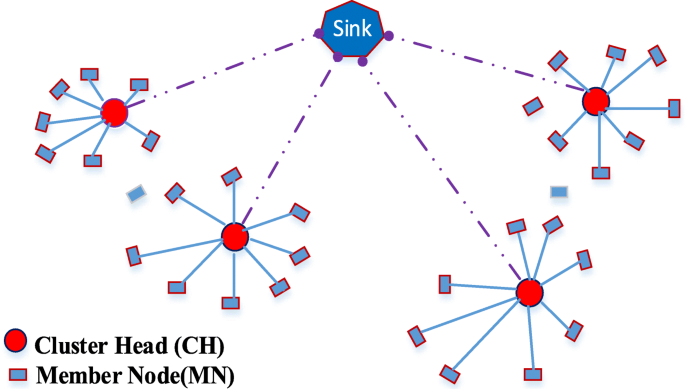In large-scale WSNs (wireless sensor networks), packets of a source node are often transmitted via multi-hop relays to reach their sink nodes. The hop-count, h, of a sink node is related to a particular hop-count originator (namely the source node) and it is defined as the least number of multi-hop relays required to send one packet from the source to the sink in this chapter. A source node can use a simple controlled flooding to set up the hop-counts relative to itself for all other nodes [1]. Let d denote the Euclidean distance between a source and its sink (the source-to-sink distance is denoted as SS-distance in the sequel), various statistical models that characterize the relationships between h and d are some of the fundamental problems in modeling large-scale WSNs. These results can be applied to address many other WSN research issues such as range-free localization, communication protocol design and evaluation, throughput optimization, transmission power control and etc.Given a WSN whose nodes are distributed randomly according to a two-dimensional homogeneous Poisson point process of density λ, we investigate two statistical relationships between hop-count h and SS-distance d in this chapter. First of all, we propose a method termed CSP (Convolution of Successive Progress) to compute the K-hop connection probability for a two-dimensional network. The K-hop connection probability is defined as the conditional probability that a sink has a hop-count h = K with respect to a source given that the SS-distance is d. Mathematically, the K-hop connection probability is defined as the conditional probability1 P(h = K|d). The CSP method is also extended into three- dimensional networks.
Secondly, based on the results of K-hop connection probability, we also present a method to compute the PDF (probability density function) of the SS-distance d conditioned on hop- count h = K, namely the PDF of SS-distance d of all nodes with a hop-count h = K. Mathematically, this conditional PDF2 is denoted as f(d|h = K). Simulation studies show that the proposed methods are able to achieve significant error reduction in computing these hop-distance statistics (i.e. the conditional probability/PDF) compared with existing methods.
1 Unless otherwise specified, the conditional probability is referred to P(h = K|d) in this paper.
2 Unless otherwise specified, the conditional PDF is referred to f(d|h = K) in this paper.
The rest of the chapter is organized as follows. Section 2 reviews some related works. Section 3 described the system models used in the analysis. The CSP algorithms for both two-dimensional and three-dimensional networks are presented in Section 4. A method of computing the conditional PDF f(d|h = K) is then discussed in Section 5. Section 6 presents simulation results and discussions. Finally, Section 7 concludes the chapter.
Relatedworks
Evaluation of various statistical models that characterize the relationships between hop- count h and SS-distance d are some of the fundamental problems in modeling large-scale WSNs. In [2], the solution of the conditional PDF f(d|h = K) for one-dimensional networks is presented. The authors of [3] and [4] derived the conditional probability P(h = K|d) based on the results of [2] for one-dimensional networks. However, only models are provided to the solution of P(h = K|d) in two-dimensional networks. In [5], the exact analytical solution of the conditional probability P(h = K|d) is derived for K = 1 and K = 2 in two-dimensional networks. However, probabilities P(h = K|d) for K > 2 were studied by analytical bounds and extensive simulations. The author of [6] proposed an iterative formulation of P(h = K|d). Though not stated explicitly in his paper, its derivation is based on an “independent assumption”. This independent assumption is then highlighted in [7]. The analytical solutions proposed in [6] and [7] are the analytical approximations of P(h = K|d) and only converges to the true statistics when the node density λ in the network tends to infinity. Due to the complexity of two-dimensional multi-hop percolation process, the authors of [8] proposed a simulation-based attenuated Gaussian approximation to model the conditional PDF f(d|H = K). All previously mentioned results are based on the deployment model that nodes are distributed according to a one-dimensional or two-dimensional Poisson process. The author of [9] provided an analytical approximation for the probability of 2-hop connection between two randomly selected nodes in network whose nodes are distributed according to a Gaussian distribution.
Another interesting relationship between hop-count and distance is known as progress per hop. Works related to this are reported in [10] – [13]. The authors of [10] derived a solution for the expected per hop progress in two-dimensional networks. The expected per hop progress problem was also studied in [11] and [12] with different applications in protocol evaluation and localization. The authors of [13] presented an analytic approach to capture statistical bounds on hop-count for a given SS-distance in a greedy routing approach.
The statistical relationships between hop-count and SS-distance can be applied to address many WSN research problems. For example, many range-free WSN localization algorithms employ the principle of hop-count-to-distance transformation to localize nodes. The DV-hop WSN localization algorithm of [14] employs a heuristics approach known as correction factor to estimate the distance between two nodes based on the hop-count between them. Similar methods are also reported in [15] and [16]. The network throughput problem and optimal transmission radii were also studied in [10] based on the analytical expression of expected per hop progress.
System model
In this section, we discuss radio channel model, node deployment model and network topology model used in this chapter.
A.Channel model
As in many WSN literatures, we adopt an unit disk channel model (in some literatures, it is also known as lossless model) in this chapter. A source can communicate directly with all nodes within a disk centered at itself with a communication range r, but cannot communicate with nodes beyond the disk. The link between a pair of nodes is also assumed to be symmetric, namely, if node A can receive packets from node B directly, then node B also can receive packets from node A directly. The disk model is often used in the theoretical analysis of WSNs. There are other realistic channel models available (such as log-normal shadowing model [17]). These realistic channel models take the random effect of noise, attenuation, shadowing and etc. into consideration. The communication between a pair of nodes is thus characterized by PRR (packet reception rate) or LP (link probability) rather than the absolute SS-distance. In this chapter, since our study is a general analysis of the statistical relationship between hop-count and SS-distance, we adopt the unit disk channel model so that the radio channel can be regarded as lossless, invariant and homogeneous.
B. Deployment model
We assume all nodes with the same communication range r are randomly deployed in a plane according to a two-dimensional homogeneous Poisson point process of density λ. Furthermore, we require that all nodes deployed can form a fully-connected network. We make use of the WSN connectivity results presented in [18] to determine suitable values of λ so that all nodes deployed can form a connected network almost surely (probability greater than 0.99).
C. Topology model
Based on the channel and deployment model, we can model the WSN as an undirect graph G. A graph G(V,E) consists a set of vertices (nodes) and edges (links), the set of vertices and edges are denoted by V and E respectively. The shortest network path between vertices
i (i ∈V) and vertices j (j ∈V) is defined as the path that travels through the minimum number of edges from i to j. Therefore, the number of edges traveled is actually the hop- count between i and j. There are many algorithms proposed in the literature to set up the shortest network path in a WSN. These algorithms are out of the scope of this work. In this chapter, we assume that the network paths and the hop-counts between all node pairs have already been set up in advance.
Convolution of Successive Progress
In this section, we propose a method termed CSP (Convolution of Successive Progress) to compute the K-hop connection probability in two-dimensional WSNs, i.e. P(h = K|d). We then extend the CSP method to compute the K-hop connection probability in three- dimensional networks.
A.Problemstatement
A formal definition of the K-hop connection probability is given in this subsection. Let h and d denote the hop-count and distance between a pair of source and sink. The K-hop connection probability is an important hop-distance statistic and it is defined as the probability that the source can reach the sink in K number of multi-hop relays given that the













































